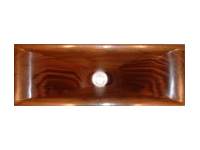Yeah, many of mine have those "round pencil eraser sized indentations" around the leading edge too. They must be injection mold riser holes. I've considered filling them to improve cosmetics, but I've never actually done that. The two-hole mount pattern is easy to use, but the three-hole pattern is difficult. You have to remove the throat plate and remove some material, in some cases. And debris is often present in the throat, but that's easy to sand smooth. When making fully assembled speakers with this horn, I always touch up the throat if debris is present. But none of these things is as annoying to me as the thin edge for mounthing. That has always been difficult.Now I see that the stock we get here in America is the same as you get in Canada. It's a good sounding horn and the price is right, but it does have its share of problems.
Personally, I used to always use the Peavey CH-3's for larger speakers, but so many preferred the H290's that I started stocking mostly those. The Professional Series four π's and a couple others always used the H290's, but most of the rest used the CH-3's. Both are good sounding horns, and I like 'em both. But mounting was easier on the CH-3's and I always thought they looked better in large speakers.
So I agree with your assessment 100%. If you really want a great horn, go for Martinelli's.
 Martinelli wood horn
Martinelli wood horn







